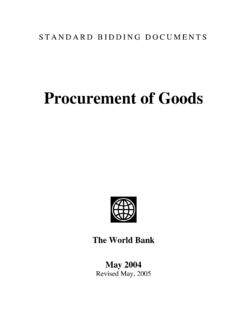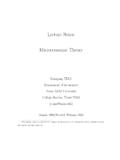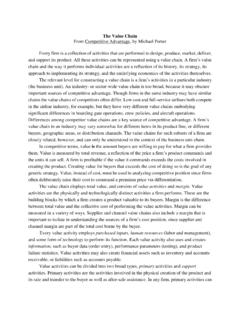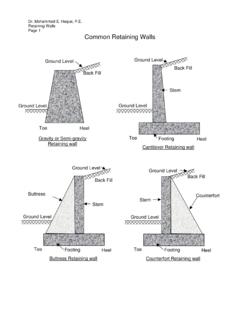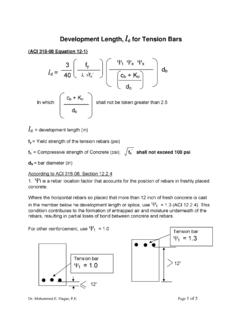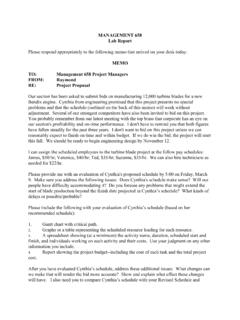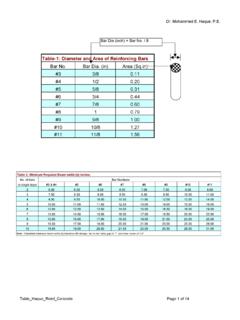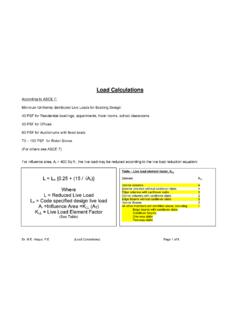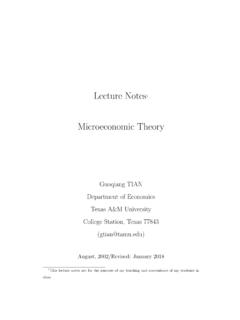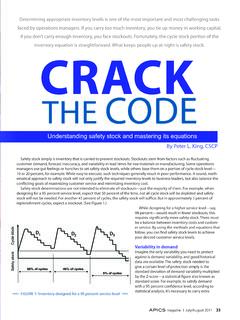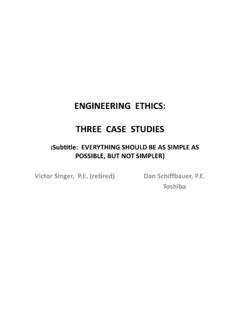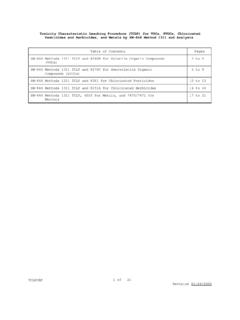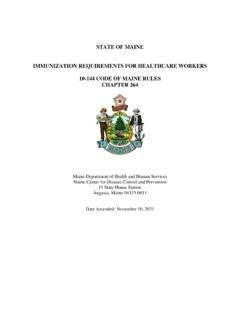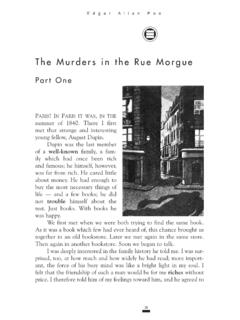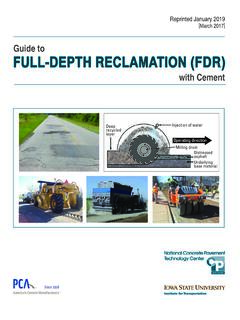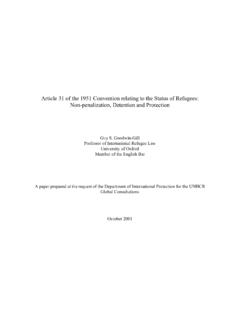Transcription of TYPES OF FOUNDATIONS
1 Lecture Note COSC 421 ( Haque) 1 TYPES OF FOUNDATIONS Foundation Systems Shallow Foundation Deep Foundation Pile Foundation Pier (Caisson) Foundation Isolated spread footings Wall footings Combined footings Cantilever or strap footings Raft or Mat foundation Lecture Note COSC 421 ( Haque) 2 Shallow FOUNDATIONS are usually located no more than 6 ft below the lowest finished floor. A shallow foundation system generally used when (1) the soil close the ground surface has sufficient bearing capacity, and (2) underlying weaker strata do not result in undue settlement. The shallow FOUNDATIONS are commonly used most economical foundation systems. Footings are structural elements, which transfer loads to the soil from columns, walls or lateral loads from earth retaining structures.
2 In order to transfer these loads properly to the soil, footings must be design to Prevent excessive settlement Minimize differential settlement, and Provide adequate safety against overturning and sliding. TYPES of Footings Isolated spread footings under individual columns. These can be square, rectangular, or circular. Footing Column Lecture Note COSC 421 ( Haque) 3 Wall footing is a continuous slab strip along the length of wall. Footing Wall Lecture Note COSC 421 ( Haque) 4 Property line Combined footings support two or more columns. These can be rectangular or trapezoidal plan. Combined Footing Footing Columns Lecture Note COSC 421 ( Haque) 5 Property line Cantilever or strap footings: These are similar to combined footings, except that the footings under columns are built independently, and are joined by strap beam.
3 Lecture Note COSC 421 ( Haque) 6 Raft or Mat foundation: This is a large continuous footing supporting all the columns of the structure. This is used when soil conditions are poor but piles are not used. Mat or Raft Footing Columns Lecture Note COSC 421 ( Haque) 7 Deep FOUNDATIONS The shallow FOUNDATIONS may not be economical or even possible when the soil bearing capacity near the surface is too low. In those cases deep FOUNDATIONS are used to transfer loads to a stronger layer, which may be located at a significant depth below the ground surface. The load is transferred through skin friction and end bearing (Figure below). Fig. 1(a) Axial Compressive Load transfer in deep FOUNDATIONS Skin friction Hard soil/ Bedrock End bearing Wf P Fig.
4 1(b) Axial Compressive Load transfer in deep FOUNDATIONS Skin friction End bearing (negligible) Wf P Lecture Note COSC 421 ( Haque) 8 Fig. 2 Axial Tension Load transfer in deep FOUNDATIONS Skin friction Wf P Fig. 3 Lateral Load transfer in deep FOUNDATIONS M V Lecture Note COSC 421 ( Haque) 9 Piles Piles cap Column Piles Piles cap Column Fig. Pile Foundation- (a) Vertical Piles; (b) Battered Piles (a) (b) Lecture Note COSC 421 ( Haque) 10 Pile Foundation Column Pile Cap Piles Lecture Note COSC 421 ( Haque) 11 Bell Column Pier shaft Pier Foundation (Caisson) Lecture Note COSC 421 ( Haque) 12 Soil properties and parameters, and Foundation Systems Frost Depth (Frost Line or Freezing Depth) is the depth to which the groundwater in soil is expected to freeze due to temperature drop.
5 The frost line varies by latitude; it is deeper closer to the poles. It ranges in the United States from about zero to six feet. Below that frost depth the temperature varies, but is always above 0 C (32 F). In Arctic and Antarctic locations the freezing depth is so deep that it becomes year-round permafrost, and the term "thaw depth" is used instead. [Reference: ] Frost Depth in USA Lecture Note COSC 421 ( Haque) 13 Frost heaving is an upwards swelling of soil during freezing conditions caused by an increasing presence of ice as it grows towards the surface. Ice growth requires a water supply that delivers water to the freezing front via capillary action in certain soils. The weight of overlying soil restrains vertical growth of the ice and can promote the formation of lens-shaped areas of ice within the soil.
6 Yet the force of one or more growing ice lenses is sufficient to lift a layer of soil, as much as 30 cm or more. The soil through which water passes to feed the formation of ice lenses must be sufficiently porous to allow capillary action, yet not so porous as to break capillary continuity. Such soil is referred to as "frost susceptible". Differential frost heaving can crack pavements contributing to springtime pothole formation and damage building FOUNDATIONS . [Reference: ] Lecture Note COSC 421 ( Haque) 14 Capillary action (capillarity, capillary motion, or wicking) is the ability of a liquid to flow in narrow spaces without the assistance of, and in opposition to, external forces like gravity. If the diameter of the tube is sufficiently small, then the combination of surface tension caused by cohesion within the liquid and adhesive forces between the liquid and the tube act to lift the liquid (Figure).
7 The capillary action is due to the pressure of cohesion and adhesion, which cause the liquid to work against gravity. [Reference: ] Water High capillary rise Low capillary rise Lecture Note COSC 421 ( Haque) 15 Soil Bearing Pressure at base of Footings A. Concentrically Loaded Footing P L W Bearing pressure, p = P/A = P/(W x L) Lecture Note COSC 421 ( Haque) 16 B. Eccentric load on Footings case I ( e1 < L/6) P L W pmax pmin Kern Boundary W/6 W/6 L/6 L/6 e1 Lecture Note COSC 421 ( Haque) 17 case II ( e1 = L/6) P L W pmax Pmin =0 Kern Boundary W/6 W/6 L/6 L/6 e1 Load Lecture Note COSC 421 ( Haque) 18 case I ( e1 < L/6) Direct Stress > Bending Stress p min = Direct Stress Bending Stress p max = Direct Stress + Bending Stress p min = (P/A) (M.)
8 C / I) p max = (P/A) + (M . c / I) where A= W x L M= P x e1 c= L/2 I = W x L3 /12 c/I = (L/2) x 12/(W x L3) = 6/(W x L2) Therefore, p min = P/(W x L) 6(P x e1) /(W x L2) p max = P/(W x L) + 6(P x e1) /(W x L2) case II ( e1 = L/6) Direct Stress = Bending Stress (P/A) = (M . c / I) P/(W x L) = 6(P x e1) /(W x L2) Therefore, e1 = L/6 p min = 0 p max = P/(W x L) + 6(P x L/6) /(W x L2) = 2P/(W x L) Lecture Note COSC 421 ( Haque) 19 case III ( e1 > L/6) P L W pmax Pmin =0 Kern Boundary W/6 W/6 L/6 L/6 e1 Load L/2 X=(L/2 e1) Lecture Note COSC 421 ( Haque) 20 case III ( e1 > L/6) As shown above, as the load, P acts outside of the kern boundary, tensile stress results at the left side. For pmax less than allowable soil bearing capacity, no uplift is expected at the left end of the footing, and the center of gravity of the triangular bearing stress distribution coincides with the point of action of load, P.
9 Downward Load = Area of upward triangular stress block x width P = (pmax) (3X)W P = 3/2 (pmax) (L/2 e1) W Pmax = 2P / [3W(L/2 e1)] Lecture Note COSC 421 ( Haque) 21C. Biaxial loading of Footing Biaxial Loading (Eccentricity about two axes): Bearing Stresses at the corners of the footing are p = P/( ) (P. ex . Cx)/Iy (P. ey . Cy)/Ix where Cx = L/2; Cy = W/2; Ix = L. W3 /12; Iy = W. L3 /12 L W X ex Load, Y ey P Lecture Note COSC 421 ( Haque) 22 P e M P e = M/P Lecture Note COSC 421 ( Haque) 23 EXAMPLE 1: A reinforced concrete footing (Fig 1) supports a 12 x12 column reaction P=100 kips at the top of footing. Based on the soil test, allowable bearing capacity of soil is 5 ksf.
10 Check the adequacy of the footing based on bearing pressure. P =100k 5ft 5ft Frost line Soil unit weight = 110 pcf 4 -0 2 -0 Slab on grade, surcharge weight = 120 psf Lecture Note COSC 421 ( Haque) 24 Solution: Since the footing is concentrically loaded, soil bearing pressure is considered uniformly distributed assuming the footing is rigid. Column load = 100 k Footing weight (5x5x2)x150/1000 = k Soil weight [(5x5) - (1x1)]x4x110/1000 = k Slab on grade surcharge weight [(5x5)-(1x1)]x120/1000 = --------------------------- Total weight on soil = k Soil pressure p = (5x5) = ksf < allowable bearing pressure 5 ksf. OK Lecture Note COSC 421 ( Haque) 25 EXAMPLE 2: A reinforced concrete footing (Fig 2) supports a 12 x12 column reaction P=100 kips at the top of footing.
